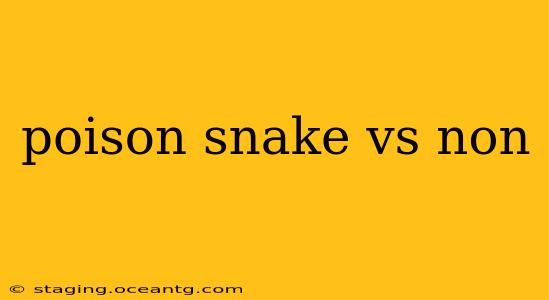Identifying poisonous snakes is crucial for safety, especially in regions where venomous species are prevalent. This guide will help you understand the key differences between poisonous and non-venomous snakes, equipping you with the knowledge to differentiate them and react appropriately. While the term "poisonous" is often used interchangeably with "venomous," there's a crucial distinction: poisonous animals cause harm through touch (like a poison dart frog), while venomous animals inject venom through a bite or sting (like snakes and spiders). This article focuses on venomous snakes.
What are the Key Differences Between Venomous and Non-Venomous Snakes?
The most significant difference lies in the presence of venom glands and fangs. Venomous snakes possess specialized glands that produce venom, and they have fangs designed to inject this venom into their prey. Non-venomous snakes lack these features. However, identifying venomous snakes solely based on appearance can be challenging, as many species have evolved camouflage and mimicry. Therefore, relying on visual identification alone is risky.
Head Shape: Fact or Fiction?
Many believe the head shape reliably distinguishes venomous from non-venomous snakes. While some venomous snakes have triangular heads (like many vipers), this isn't a universal rule. Many harmless snakes also have triangular or broad heads, and conversely, some venomous snakes have slender heads. Head shape alone is an unreliable indicator.
Pupil Shape: A More Reliable Clue (Sometimes)
Pupil shape offers a slightly more reliable, though not foolproof, method of identification. Many venomous snakes, particularly pit vipers, have elliptical or cat-like pupils. However, numerous non-venomous snakes also share this characteristic. It’s important to consider this feature alongside other identifying factors.
Heat-Sensing Pits: Unique to Pit Vipers
Pit vipers (a family of venomous snakes) have heat-sensing pits located between their eyes and nostrils. These pits detect infrared radiation emitted by warm-blooded prey, allowing them to strike accurately even in darkness. The presence of these pits is a definitive indicator of a pit viper, a venomous snake family. However, the absence of pits doesn't automatically mean the snake is non-venomous.
Fangs: The Definitive Feature (But Difficult to Observe)
The presence of hollow or grooved fangs is the most reliable indicator of a venomous snake. However, safely observing fangs requires close examination, which should only be done by trained professionals. Attempting to get close enough to a potentially venomous snake to examine its fangs is incredibly dangerous.
How Can I Tell if a Snake is Venomous Without Getting Close?
The safest approach is to maintain a safe distance and avoid handling any unknown snake. If you're unsure about a snake's venom status, assume it's venomous and stay away. Observe it from a distance, noting features like head shape, pupil shape, and the presence of heat-sensing pits (if visible). Take a picture from a safe distance (if possible), and if you're in an area with potentially dangerous snakes, consult with a local wildlife expert or herpetologist for identification.
What Should I Do if I Encounter a Venomous Snake?
- Remain Calm: Panic can lead to impulsive actions.
- Maintain a Safe Distance: Slowly back away without making sudden movements.
- Do Not Attempt to Handle the Snake: This is extremely dangerous.
- Seek Medical Attention: If bitten, immediately seek medical attention. If possible, note the snake's characteristics (color, pattern, size) to aid in identification and treatment.
- Call Emergency Services: In many regions, emergency services have specific procedures for venomous snake bites.
Is it Possible to Differentiate Venomous Snakes Based on Color or Pattern?
No, relying solely on color or pattern is unreliable. Many venomous and non-venomous snakes share similar coloration, and variations within a species are common.
What are the Common Myths About Identifying Venomous Snakes?
Many myths surround venomous snake identification. Ignoring these myths is crucial for safety. Don't rely on single characteristics or folk wisdom to determine if a snake is venomous. Always err on the side of caution and assume it could be venomous unless positively identified as harmless by a professional.
This information is for educational purposes only and should not be considered a substitute for professional guidance. When in doubt, always seek the advice of experienced herpetologists or wildlife experts. Safety and responsible observation are paramount when encountering snakes in the wild.
